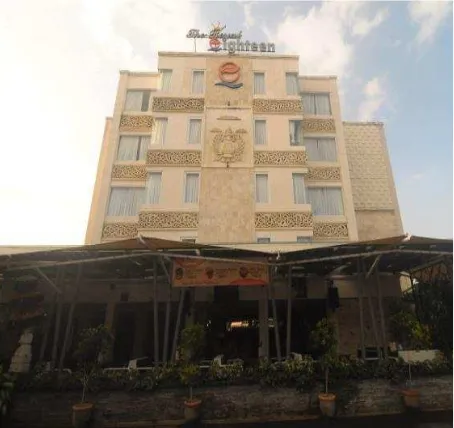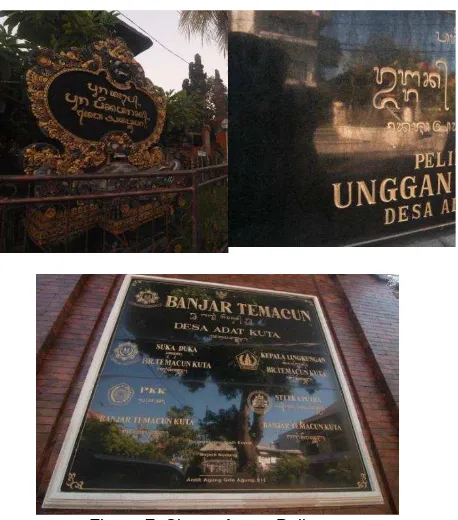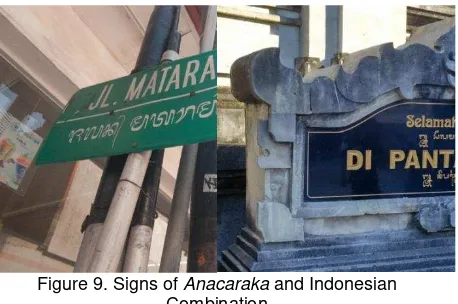82
GLOCALIZATION OF BALINESE LANGUAGE
AS OUTDOOR SIGNS IN DESA ADAT KUTA BALI
I Wayan Mulyawan
Udayana University
moelya0178@gmail.com
First draft received: 1 February 2017 Final proof received: 27 August 2017
Abstract
As a tourist destination, Kuta has become an international village which forces the native to use more English than Balinese in their working life. One of the most visible media of communication in Kuta is in the form of out-door sign. Out-door sign is considered to be the most effective mass media communication and the study is known as Linguistic Landscapes. The focus of this study is to investigate the glocalization of Balinese language as a medium of communication in Kuta especially, on out-door signs. The data of this study were collected by taking pictures of all out-door signs in Kuta area, such as Raya Kuta St., Kartika Plaza St., Pantai Kuta St., and Legian St.. The data were classified into two main types: commercial signs and non-commercial signs. The analysis started with identification of the language use and followed by a combination of language use in all signs. The finding shows that Balinese language is only used in 43 signs out of 1132 signs. Furthermore, from the 43 signs, there are only 22 using pure Balinese, 19 signs using Indonesian with Balinese Letters, and 2 signs using a combination of Balinese and Indonesian. The conclusion of the study is that the glocalization of Balinese language is not yet achieved; in fact, Balinese language is marginalized in Bali as out-door signs.
Keywords: out-door signs; Balinese; Balinese; Glocalization.
To cite this paper (in APA style):
Mulyawan, I. W. (2017). Glocalization of Balinese language as outdoor signs in Desa Adat Kuta Bali. International Journal of Education, 10(1), 82-87. doi: http://dx.doi.org/10.17509/ije.v10i1.5042
INTRODUCTION
In this era of globalization, as one of tourist destinations, Kuta faces an absolute threat of losing its local identity, especially its language in daily life use. Giulianotti and Robertson (2007) believed that globalization processes always endanger the local. Therefore, Kuta should try to make its local genius part of globalization and become glocalization. Majidi (2013) stated that local languages can only be saved when they are in use. In order to survive in globalization era, the involvement of local language in international interactions and communications is required. The involvement of local language in international communication in a certain area is called glocalization of language. Besides Balinese language, many other local aspects can be glocalized in Kuta, such as architectures, fashion, and ritual/ceremonies. Some examples of this glocalization can be seen in Figure 1 and Figure 2.
In terms of architecture, the Government requires all buildings in Bali to be not more than 15
83 Fig. 1. Glocalization of Balinese Architectural Style.
Fig. 2. Glocalization of Balinese Costume and Ritual in Hotel/Restaurant
Glocalization process of Balinese language is not to be found in daily conversation between local and foreigners, since Balinese is not understood by foreigners. English is the primary language used in Kuta, especially in hospitality business.
This study attempted to analyse the glocalization process of Balinese language in the global use of English in Kuta. The glocalization focus is in the use of Balinese language as a medium of out-door signs.
Language is an important instrument for human in social life. It is used as a means of communication, either in written or spoken language. Nowadays,
written language has unconsciously become a dynamic means of communication, not just between humans but also between human and the environment.
In our every daily life, we encounter many signs in our environment. With or without our awareness we have active communications with those signs and they have served an essential part in our life. The signs may include traffic signs, street names, place names, billboards, and many more.
Saussure considered language as a
communication system that involves concept and sound image. The sound image is a signifier and a concept is a signified.
The bond between the signifier and the signified is arbitrary, there is nothing in either the word or the thing that makes the two go together, no natural, intrinsic or logical relation between a particular sound image and a concept (Saussure, pp. 2-3)
Different from Saussure, Ogden & Richards (1923) added a connecting element between signifier and signified. The connector is called thought or reference. They said that there is no direct link between symbol and referent (between language and the world)—the link is via thought or reference, the concept of our mind. The relationship between these three is known as semiotic triangle.
In term of functions, out-door signs are divided into two types; they are Non-commercial sign and commercial sign. Mulyawan (2016) stated that Non-commercial sign is used by a charitable organization and government that mainly aims to provide information or motivate people to react as a response to the information served without any profit orientation. On the other hand, commercial sign is used by producers to promote their product to gain profit. Furthermore, Mulyawan (2016) focused his analysis on the meaning and structure of printed non-commercial ads that were found in magazines. Meanwhile, in the current study the analysis is on the use of Balinese language as non-commercial ads which act as mass communication through outdoor signs, as part of the glocalization process.
The occurrence of many out-door signs along the side ways of Kuta area is considered to be an aspect of globalization. Sign is considered to be the most effective way to communicate something to the public. The study of out-door signs or Linguistic Landscape (LL) is a study about written language through all signs in our environment which give a great influence on our daily activity. These signs include traffic signs, place names, commercial ads, etc.
84 study of LL. They define all out door signs such as public road signs, advertising billboards, street names, places names, commercial shop signs, and public sign on government buildings as parts of mass language that forms the LL.
Akindele (2011, pp.1) discussed LL as a form of public communication in Gabrone, Botswana. He discovered that LL influences the forming and development of Gabarone Botswana language in the forms of common pattern of language usage, official language policies, prevalent language attitudes, and the long-term consequences of language contact, among others. Similar to Akindele, Huebner (2006) found that the diversity of language uses in the urban area of Bangkok reveals the extent of linguistic diversity in a large metropolitan area that offers evidence of a shift from Chinese to English as the major language. These facts proved the significant influences of LL on the use of language in the society.
Furthermore, Ben-Rafael et al. (2006) studied the LL use in Israel as a symbolic language construction in public area. They found that the language combination used in outdoor signs determines the community that lived in the area, such as Hebrew-English signs prevail in Jewish communities; Arabic-Hebrew in Israeli-Palestinian communities; Arabic-English in East Jerusalem.
Based on all previous studies above, Mulyawan (2017) tried to find the use of outdoor signs in Kuta, especially the occurrence of commercial outdoor signs. The result showed that commercial outdoor signs in Kuta are a reflection of what is needed and vital as a result of global development as a tourist destination. The study also showed that all commercial outdoor signs are part of facilities to support the development and sustainability of Kuta as an international tourist destination.
In this study, the focus is entirely different from all previous studies. The present research is not to find about the occurrence of languages on outdoor signs in certain areas, to identify the involvement of Balinese language as part of international communication in a medium of outdoor signs, or known as the process of glocalization of Balinese language.
METHOD
This is a qualitative research, which analyses the use of Balinese language in out-door signs. The data of the study is all of out-door signs in Desa Adat Kuta. The data were collected by taking photographs of any out-door signs found in Kuta. The research areas international village. This condition makes Kuta very
suitable as research location in order to analyse the rules and existence of local language among foreign languages.
All collected data were categorized into two main types; they are commercial signs and non-commercial signs. The categorization was made based on the function of each out door sign. All data of commercial signs were divided into 3 sub-members; they are rental, etc. Commercial good product is sign that gives information about goods that are sold to the customer, such as bar, restaurant, art shop, convenience store, etc. Lastly, commercial others refer to signs that are not for selling services or goods, such as leasing offer, opening soon sign, etc.
Non-commercial national is a sign that is made and placed by the government, such as traffic sign, trash bin, etc. Non-commercial local refers to signs that are made by local people or government that use Balinese language or Balinese Letters, such as Place name, Street names Local building names, etc. non-commercial others are signs made by the local, but not using any Balinese language or Letters, such as local signage of no littering, etc.
After all LL data were collected, the next step was data analysis. The analysis began with the use of language in all the signs, and then followed by analysing the use and importance of mass communication of Balinese language as outdoor signs.
FINDINGS
85 Table 1. Data Presentation
ITEM TOTAL PERCENTA
GE
Commercial signs 805 71,11%
a. Commercial Service 345 30,48% unfortunately not all of them use Balinese. These data can be divided into four groups; they are signs with Balinese language and letters, combinations of Balinese and Indonesian, Balinese letters with Indonesian, and lastly Indonesian.
The use of pure Balinese and anacaraka is found in 22 signs. These signs are signs of local buildings, especially bale banjar (local community services building), temples, and cemeteries. On the other hand, the use of a combination of Balinese and Indonesian is found in 2 signs, one of which is also combined with English. These signs are a sign of acknowledgement of local building.
Lastly, the combination of Balinese Letters (anacaraka) with Indonesian is discovered in 19 signs. These signs are not Balinese language signs, but Indonesian with anacaraka letters. Although they are not Balinese, they still show Balinese language features. These signs are mostly street names and some greetings signatures. More details of these findings are presented in table 2.
Table 2. Data of Non-Commercial Local
LANGUAGE USE TOTAL
Pure Balinese Language and Letters 22 Combination of Balinese and Indonesia. It covers 17.52 km2. In the northern part is North-Kuta district; in the middle is Kuta sub-district, and in the south is South-Kuta sub-district. Kuta has five villages, namely Kuta, Legian, Seminyak, Tuban, and Kedonganan. The research
location is in Kuta Village or known as Desa Adat
Kuta, which is located in Kuta sub-district.
Figure 4. Map of Kuta
Balinese language is the mother tongue of Balinese people. It is divided into 3 categories; they are Basa Bali Alus Singgih, Alus Madya and Alus Sor. Besides that, Balinese language has its own syllabic letters system, known as anacaraka (Mulyawan, 2014). In written form, Balinese may use Latin word or Balinese Letters (anacaraka).
Figure 5. Anacaraka (Mulyawan, 2014)
Balinese language is expected to be taking parts in globalization that affects Kuta as one of tourist destinations in Bali. The glocalization process of Balinese language is the process to introduce the use of Balinese in active communication among Balinese and tourists. Ideally, Balinese should be used as one means of communication for local people to the tourists, but none of the tourists. either domestic or foreigners, understand Balinese.
Based on that fact and the need of transaction, Balinese people start to learn English and Indonesian as business language. English is widely used to communicate with foreign tourists and Indonesian is used to communicate with domestic tourists.
86 The finding showed that, there are 1,132 out-door signs found in Kuta. There are 805 commercial signs, and there are 327 non-commercial signs. The most frequent sign found is commercial of goods with a total of 451 signs, and the least frequent sign found is non-commercial local, with only 70 signs.
As it was stated by Akindele (2011) and Huebner (2006), outdoor signs are truly the representation of the environment. But, instead of determining the forming of language used, the outdoor signs in Kuta are the representation of the need of a tourist destination. The language that is used is mostly English, which is considered a universal language and known by most foreign tourists and also understood by domestic tourist and the local. Unfortunately, there are only few of the outdoor signs using Balinese language. This is one the effects of globalization that happens in Kuta.
Based on the distributions of the locations of the Commercial signs, it was found that, the outdoor signs in Kuta do not show any specific clusters. In fact, commercial signs are equally distributed throughout Kuta areas. It means that almost wherever one goes throughout Kuta, there will be hotels and restaurants. These conditions do not correspond to the research of Ben-Rafael et al. (2006), which considered that the language used on outdoor signs is the representation of the society in certain areas.
Besides English language, some of the signs use French, Korean, Chinese, Russian, Dutch and Japanese. Most of these languages are used in a combination or as a translation. For example, figure 6,
the sign of an ATM and phone booth
(telecommunication services), uses more than one language.
Figure 6. ATM and phone booth using a combination of several languages
Figure 7. Signs of pure Balinese
As it is stated before, glocalization is a process of using local genius, in this case Balinese language to be part of international communication in international community such as Desa Adat Kuta. Figure 7 shows some samples of pure Balinese used as mass communication to identify local objects. Although they are made for local people, these signs also have a glocalization function to introduce Balinese language and letters to all tourists.
Figure 8. Signs of Balinese and Indonesian Combination
Figure 8 is a sample of a combination of Balinese and Indonesian with English translation. All tourists will
read and understand what ‘Candi Bentar’ means. So,
87
bentar’ to the world as a big Balinese entrance or gate.
Figure 9. Signs of Anacaraka and Indonesian Combination
Lastly, figure 9 is a sample of a combination of Balinese letters with Indonesian. In these signs, Balinese letters are not the representation of Balinese language. It was purely a direct translation from the Indonesian. These signs are made as a reminder to all tourists that they are in Bali, which is also considered as a process of Balinese glocalization.
CONCLUSION
Glocalization is an important process to be done in order to save the local from globalization effect. Desa Adat Kuta, as one of the famous tourist destinations in Bali, also faces threats of globalization. In order to save local genius, such as language, art, and culture, from the effects of globalization, glocalization of local should be promoted.
Balinese language is expected to be glocalized in Kuta in the forms of out-door signs. Based on the analysis, it was found that only 22 signs use pure Balinese, 2 signs a combination of Balinese and Indonesian, and 19 signs using Balinese letters as a translation of Indonesian. This finding shows that Balinese has not yet achieved the glocalization in Kuta, since it is not used as mass communication sign, but only by Balinese people to promote their identity, such as temple names, cemetery, and Bale Banjar. Balinese has not been used for commercial sign purposes, which could involve more interactions with the foreigners. From this study, it can be learnt that Balinese language is marginalized by foreign languages in Bali, especially in Desa Adat Kuta, and it has not been fully glocalized.
REFERENCES
Akindele, D. O. (2011). Linguistic landscapes as public communication: A study of public signage in Gabarone Botswana. Macrothink
Institute: International Jurnal of Linguistics, 3(1), E39.
Ben-Rafael, E., Shohamy, E., Amara, M. H., & Trumper-Hecht, N. (2006). Linguistic landscape as symbolic construction of the public space: The case of Israel. Clevedon:
International Journal of Multilingualism, 3(1), 7-30.
Giulianotti, R. & Robertson, R. (2007). Forms of glocalization: Globalization and the migration strategies of Scottish football fans in North America. Sociology, 41(1), 133-152.
Huebner, T. (2006). Bangkok’s linguistic landscapes: Environmental print, codemixing and language change. Clevedon: Multi Lingual Matters Ltd. Landry, R., & Bourhis, R, Y. (1997). Linguistic
landscape and ethnolinguistic vitality: An empirical study. Journal of Language and Social Psychology, 16, 23-49.
Majidi, A. (2013). English as a global language: Threat or opportunity for minority languages?.
Mediterranean Journal of Social Sciences, 4(11),33-38. Doi:10.5901/mjss.2013.v4n11p33 Mulyawan, I. W. (2014). Aksara suci umat Hindu (Suatu kajian scriptography). Proceedings of
Seminar Nasional Bahasa Ibu VII, 606-612. Denpasar: Udayana University.
Mulyawan, I. W. (2016). Structural analysis of IFAW.org advertisement. Jurnal Ilmiah
AURORA, 178-187.
Mulyawan, I. W. (2017). Linguistics landscapes: Commercial outdoor sign in Kuta Bali.
International Journal of Lingustics, 9(2), 1-9. doi:10.5296/ijl.v9i1.10761
Ogden, C.K., & Richards, I. A. (1923). The meaning of
meaning. London: Kagen Paul.



